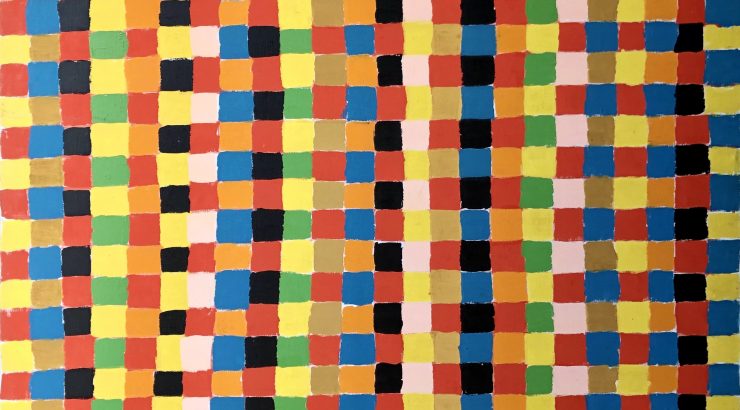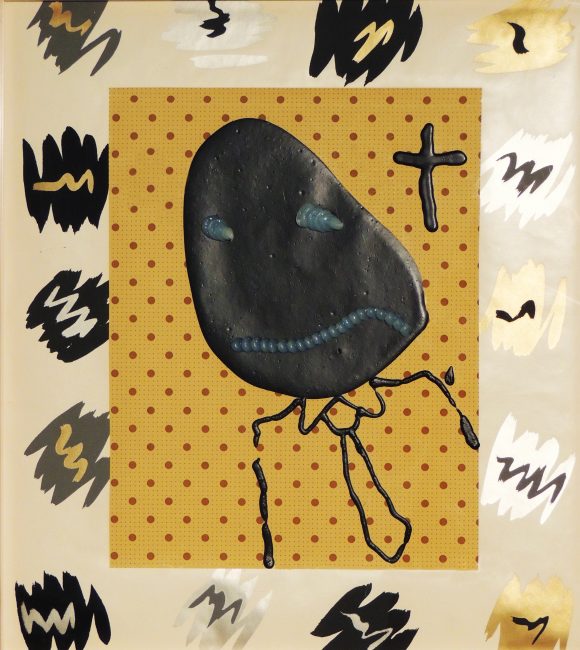In the Absence of a Name: Highlights from the Escalette’s Untitled Works
July 16, 2024
A name, in essence, is both a connector and a separator. It is how we recognize and remember each other and other things, connecting us to and distinguishing us from another. Yet, in all of its subjectivity, art sometimes abandons an identifier, leaving room to fill in the blank. Through a selection of untitled works in the Escalette Collection of Art, an academic unit of Wilkinson College, this spotlight will explore what stands in the absence of a name.
This work by prolific artist Lari Pittman likely emerged during his time receiving an art education before he was known for his large panels confronting themes of love, sex, death, and more. Having embraced decoration and embellishment at the teaching of his school’s feminist program, which valued traditionally feminine art forms, this collage exists from the early days of his experimentation with the medium. At its center resides the form of a face with molten eyes and a string of pearls-like mouth. The head sits atop the outline of a collared shirt and tie and is accompanied by a cross in the upper right corner. These elements amplify Pittman’s unique approach to symbolism and form.
In contrast to the organic forms more commonly associated with Marc Pally’s work, this early creation features a distinct geometry with sharp shapes set against a textured background. The composition is striking, with the angles and intersecting forms creating a sense of movement and tension. The juxtaposition of these angular shapes with the softer, more organic background adds a tangible depth. “The value of conceptualizing one’s practice is intrinsic to the creation and reception of much art. My Cal Arts education brought me to the fountainhead of conceptualism. Since those days in graduate school my practice has evolved to embrace sensory and intellectual modalities as conjoined twins in the dance of meaning, experience, and pleasure” (Pally).
This vibrant piece by Chapman’s own professor emeritus of art, William (Bill) Boaz, captures the eye with its bold and rhythmic checkerboard pattern. A dynamic interplay of colors featuring a grid composed of small, square blocks in a diverse palette creates a lively visual effect, drawing the viewer into a seemingly endless dance of hues. The grid structure is meticulously organized, yet the slight variations in color and size give the piece an air of spontaneity. The result is a mesmerizing tapestry that balances order with vibrancy, making each square an integral part of the whole composition.
Known for his vivid artworks that exude an alive energy and kinetic quality, Eric Freeman employs a palette dominated by ethereal shades of yellow and white, set against a soft, muted background in this untitled piece from 2001. The work features a series of interconnected, flowing lines and shapes that appear to dance across the canvas. These lines, varying in intensity and opacity, capture a moment of motion, suggesting a constant state of flux. The composition is both chaotic and harmonious, with the work’s abstract nature and delicate balance of color and form contributing to its overall vibrational energy, making it seem as though the piece is alive.
This work by Harold Gregor predates his ascension to renowned Midwest landscape painter and hints at his schooling during the generation of abstract expressionism, presenting a scene that appears to blend abstract and figurative elements. A reclining nude figure at its center is surrounded by stylized forms, including two more abstract figures. The background elements suggest an indoor setting, a room with curtains and patterned surfaces. The interaction of the abstract with the more defined forms showcases Gregor’s ability to merge different artistic influences and techniques.
Edward Givis is an artist known for his meticulous graphite drawings that bring in his marketing and advertising experience. His works often blur the lines of recognizability with extreme closeups. Givis’s precision with graphite allows him to create detailed, almost sculptural images on paper, inviting consideration of the essence and structure of the forms he presents. This particular graphite drawing features a central form (a spade) against a lighter background. The smooth gradients and sharp contrasts create a three-dimensionality with elegant simplicity. Light and shadow not only define the central form but also imbue it with a mystery in its magnified state.
Lacking a title, art unveils its most profound characteristic: the power to evoke personal interpretation and emotional connection. Through these untitled works in the Escalette Collection, we may meet the artwork as an individual, unencumbered by predetermined narratives. By embracing the untitled nature of these works, each piece becomes a mirror, reflecting our thoughts, emotions, and imaginations, making the experience of art profoundly personal and infinitely rich. In the absence of a name, these works are an enduring sanctuary for ever-changing interpretations and eternal artistic expression.
Further reading:
https://bombmagazine.org/articles/1991/01/01/lari-pittman/
https://www.artsy.net/artist/eric-freeman
https://haroldgregorartist.com/about-test-page
https://www.platformart.com/artists/edward-givis
We invite you to explore all the works in the Escalette Collection by visiting our eMuseum.
Wilkinson College of Arts, Humanities, and Social Sciences is the proud home of the Phyllis and Ross Escalette Permanent Collection of Art. The Escalette Collection exists to inspire critical thinking, foster interdisciplinary discovery, and strengthen bonds with the community. Beyond its role in curating art in public spaces, the Escalette is a learning laboratory that offers diverse opportunities for student and engagement and research, and involvement with the wider community. The collection is free and open to the public to view.








